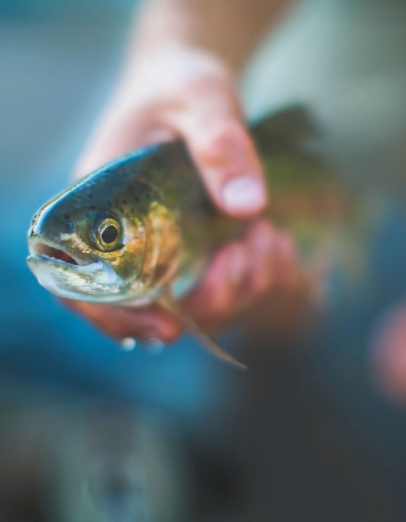What Fish to Dish Up Now?
Fish has long been touted as a superfood, a brain food and an all-around health food. This used to be unequivocally so, with no caveats regarding its safety. That was when our waters were cleaner, and the fish and seafood that came from them were purer sources of inherent nutrients.
It’s true that most fish and seafood are high in protein and low in fat. Oily fish contains high levels of omega-3 fatty acids (EPA and DHA) that can strengthen our brain cells and protect them from disease. These essential fatty acids also make fish an important anti-inflammatory food, a valuable addition to the western diet in this age of overly processed and inflammatory fare. According to the Harvard School of Public Health, “There is strong evidence that eating fish or taking fish oil is good for the heart and blood vessels ... eating approximately one to two 3-ounce servings of fatty fish a week ... reduces the risk of dying from heart disease by 36%.”
The question then is where to obtain the safest fish, unsullied by pollutants?
Environmental toxins such as methyl-mercury and PCBs taint waters worldwide. These contaminants lodge in the fat of the fish, which is also where the coveted omega-3 fatty acids reside. Briefly, methylmercury is a toxic heavy metal that, via the burning of fossil fuels, trash and medical waste, has contaminated waterways. PCBs are synthetic chemicals that were once used in hydraulic fluids and oils and are absorbed into the bodies of fish. When bigger fish eat smaller fish they accumulate greater concentrations of PCBs in their flesh, which can reach levels that are thousands of times higher than the PCB levels in the water itself. The risk to humans is impaired neurological development that poses the greatest threat to fetuses, infants and children, and hence, pregnant women. However, methyl-mercury poisoning can affect everyone.
So you want to approach this wonder-food with caution, especially if you are feeding a child or yourself during pregnancy. Federal, state and local governments issue fish consumption advisories when fish are unsafe to eat. In New York State you can find specific information on the Department of Environmental Conservation website. Bordering the eastern edge of Albany, the Hudson River travels from the Adirondacks to New York City and, unfortunately, has been heavily polluted over the years by industrial waste. Despite signs warning of its contamination, people do continue to fish there and eat their catch. Above Albany County, in Saratoga County, the waters clean up quite a bit, but the advice is still to check the DEC website carefully for information. In general, the farther north in New York State you go to fish, the better the water quality will be.
Even large species “wild” fish need to be monitored for their contamination levels. A great source for this information is the Monterey Bay Aquarium, which regularly updates guidelines on what is safe and sustainable to eat.
Canned tuna is the most widely eaten fish in the U.S. and the most common source of mercury exposure for Americans. The Environmental Protection Agency and the Food and Drug Administration recommend limiting consumption of conventional tuna, otherwise known as white albacore, to roughly six ounces every 10 days for an adult. However if you are a tuna fan there is another option, and that is to avoid conventional tuna altogether. Instead, opt for light tuna. Light tuna is not an actual species of fish, but can include bigeye, skipjack and/or yellowfin. The catch consists of younger fish that have had less time to absorb methyl-mercury. Make sure to look for a label that says pole or troll caught, ensuring no dolphins were inadvertently killed in the fishing process, another concern for tuna eaters. The advisories for light tuna consumption allow for three times the amount!
For a long time farmed fish were to be avoided because of overcrowded and unhealthy growing conditions. However, sustainably raised fish are now often a safer choice than wild-caught because conditions are controllable and have improved. There is no “organic” certification for fish or seafood in the U.S., based on the assumption that it is impossible to standardize conditions in open waters. There are other countries that do issue organic certifications, but bear in mind when you see these labels that their organic standards may differ widely from those in the U.S.
Non-fish eaters can still reap the health benefits omega-3s provide! One alternative is to take a fish oil supplement. Today’s best option is sourced from krill, which is not contaminated as fish oil can be. Plant-based sources of omega-3s include flaxseed, walnuts, soybean and canola oils. These differ from the omegas in fish, but the body can partially convert them to EPA and DHA. All are beneficial to your health!
If you want to reap the substantial health benefits that eating fish and seafood can provide, you have to sidestep the obstacles and stay on top of the advisories. Remember that safety is not based on just the source, but also the species of fish. Paying close attention to these factors ensures that fish can remain a super healthy food in your diet.
LEARN MORE
Here are three online resources with good charts that can help you make the best decisions on which fish to eat.
Regional Fish Health Advisories Chart: health.ny.gov/environmental/outdoors/fish/health_advisories/regional
Free Booklet on Eating Sportfish and Game: health.ny.gov/publications/2800.pdf
Learn about tuna risks and regulations per the FDA and EPA: nrdc.org/health/effects/mercury/tuna.asp





